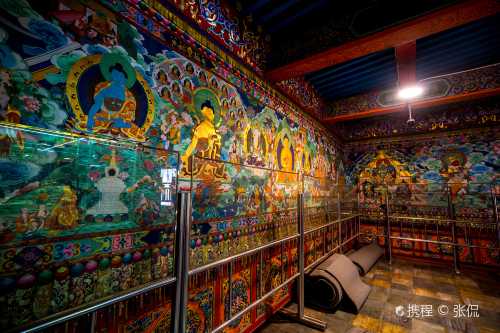Popular Trip Moments
Magical Family Adventure | Summer Expedition through Volcanoes, Grasslands, and Deserts | The combination of Han and Tibetan is magnificent and gorgeous|Hohhot Xilitu Zhao | Hohhot Wanda Mandarin Hotel, A Home Away from Home | Grassland Paradise: Inner Mongolia's Majestic Scenery and Mysterious Culture | Green water and green mountains are beautiful and suitable for family travel | Shahukou | A delightful stay at the Shangri-La Hotel, Hohhot! | Beyond the Great Wall: Essential Guide to Hohhot | Visit the Jokhang Temple in Hohhot: A pious journey through time and space | Uncover the Secrets of the Silver Buddha and Red Walls! One-Day Whirlwind Tour of Dazhao Temple | Chi Le Chuan Grassland: Encountering the Poetry and Romance Beyond the Great Wall | eLong Hotel, your cozy travel haven! | Hohhot Travel: A Dreamy Combination of Grassland and Desert | Explore Hohhot Through the Lens of Hayao Miyazaki | Hohhot | A volcano + desert trip on May Day | Successfully Visited Inner Mongolia's Desert "Disney," So Fun I Didn't Want to Go Home | The most beautiful tea culture-themed hotel in Hohhot. Another stay at She Yi. | Stay at Juhua International Hotel and enjoy the beautiful view of Hohhot | Just one step west of Beijing is Ulanqab, a grassland summer resort! | A Fun-filled Trip to Hohhot – The Experience You Won’t Forget! 🐑🌄 | Guide | What I Must Say After Living in Hohhot for 20 Years... | Check in to Jifeng City Hotel (Kashgar Old City Ethnic Commercial Street East Lake Park Branch) | Hohhot Hotel Recommendation | The Grand House International Hotel is Amazing! | Hohhot: A City of Faith, Food, and Grasslands | Inner Mongolia is stunning in all four seasons! China's New Zealand | An old Shanghai villa B&B hidden among the plane trees! | Ulanqab-Ordos 2-Day Tour | A Spring Feast of Flowers | Visiting Dazhao in Hohhot, Inner Mongolia | How can I describe the long summer dream that belongs to Inner Mongolia? | Hohhot's Hogwarts: A Gothic Church Must-See in Winter
Popular Travel Types
Recommended Attractions at Popular Destinations
Bangkok attraction near me | Manila attraction near me | Tokyo attraction near me | Taipei attraction near me | Hong Kong attraction near me | Seoul attraction near me | Kuala Lumpur attraction near me | Los Angeles attraction near me | Shanghai attraction near me | New York attraction near me | Shenzhen attraction near me | Osaka attraction near me | Singapore attraction near me | London attraction near me | Guangzhou attraction near me | San Francisco attraction near me | Beijing attraction near me | Macau attraction near me | Bali attraction near me | Jakarta attraction near me | Paris attraction near me | Ho Chi Minh City attraction near me | Istanbul attraction near me | Phuket attraction near me | Chicago attraction near me | Seattle attraction near me | Toronto attraction near me | Orlando attraction near me | Cebu attraction near me | Chiang Mai attraction near me
Popular Attractions
Chengyang Bazhai Scenic Village | Tang Paradise | Chengdu Du Fu Thatched Cottage Museum | Tiger Kingdom - Phuket | Yanoda Tropical Rainforest | Damnoen Saduak Floating Market | Shanghai Museum | Dukezong Ancient Town | Xingping Ancient Town | Dujiangyan Scenic Spot | Shixiang Lake | Hong Kong Disneyland | WILD LIFE Sydney Zoo | Zhonghua Dongtian | Beijing Wildlife Park | Grandview Mall | Incheon Chinatown | Currumbin Wildlife Sanctuary | Platja de Agua Amarga | Shiv Mandir | Konglonghuashi Museum | MOSQUE JAMIE AL-iSLAM | Fresque "guerriers Bantous-04" | San Pascual Municipal Museum | Radha Krishna Temple Garden | Shiv mandir | PLAZA DEPARTAMENTAL TUPUNGATO | Centre Culturel de Wangenbourg Engenthal | Wisata Petik Jeruk Desa Selorejo | Kiwi Park Queenstown
Popular Restaurants in Hohhot
呼和浩特香格里拉大酒店·馨咖啡海鲜自助 | EERDUN | Shang Palace | Gerilei'ama (bayi) | 额尔敦传统涮 | 老·贝尔杂碎馆 | Race Course Mongolia Great Camp | Gerilei'amanai Teahouse (jiangjunyashu) | 源玺源烧麦馆(地质局北街店) | 西贝莜面村(满都海公园店) | 泽成冰煮羊(三分店) | 蒙亮盛宴(蒙古包区) | Gerilei'ama (zhonghai) | Grandma | Ban MuDi YouMian DaWang (JiaLi Mansion) | 赛诺草原羊·涮肉烧烤蒙餐 | Rong jiu jiu yang ji gu Hot Pot (mo'erchengdian) | XiBei YouMian Cun | Laosuiyuan Shaomai (Dazhao) | 塞伊德蒙餐(兴安南路店) | 宴遇英雄汇功夫酱骨(内蒙总店) | GE RI LE A MA NAI CHA GUAN JIN QIAO DIAN | 泰享捞泰式阴功涮坊(摩尔城店) | 胡椒记烤肉(公园西门店) | 莫萨里拉比萨·手工(万达店) | Caowokao Duck (mandouhai) | 辣喔诱重庆老火锅(海亮店) | Xibeiyoumiancun (daxuedonglu) | 芝士工厂(阳光诺卡店) | 格日勒阿妈(巨海店)
Popular Ranked Lists
Popular Premium Hotels in Palakkad | Popular Premium Hotels in Brentwood Bay | Top 10 Local Restaurants in Wuyuan | Popular Luxury Hotels Near Fahaheel | Popular Best Things to Do in Barcelona | Top 10 Local Restaurants in Porto | Popular Luxury Hotels Near Odiaxere | Top 9 Local Restaurants in Weifang | Popular Luxury Hotels Near Toap | Top 3 Best Things to Do in Linxia Prefecture | Popular Best Things to Do in Prague | Top 15 Best Things to Do in Oslo | Popular Best Things to Do in Milan | Top 3 Local Restaurants in Lu'an | Top 5 Local Restaurants in Xuancheng | Popular Premium Hotels in Miches | Popular Premium Hotels in El Seibo | Popular Best Things to Do in Paris | Top 10 Local Restaurants in Rongcheng | Top 9 Local Restaurants in Pingyao | Popular Premium Hotels in Mobile | Popular Luxury Hotels Near Boljoon | Top 10 Local Restaurants in Rizhao | Top 7 Best Things to Do in Phnom Penh | Top 5 Best Things to Do in Vladivostok | Popular Luxury Hotels Near En Gev | Top 6 Best Things to Do in Glasgow | Top 4 Best Things to Do in Pingyao | Popular Best Things to Do in Athens | Popular Local Restaurants in Huanggang
Payment Methods
Our Partners
Copyright © 2025 Trip.com Travel Singapore Pte. Ltd. All rights reserved
Site Operator: Trip.com Travel Singapore Pte. Ltd.
Site Operator: Trip.com Travel Singapore Pte. Ltd.



















